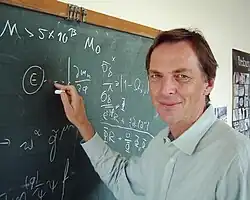Christof Wetterich
Christof Wetterich | |
|---|---|
 | |
| Born | April 12, 1952 |
| Alma mater | |
| Known for | |
| Awards | Max-Planck Research Prize (2005) |
| Scientific career | |
| Fields | Theoretical physics |
| Institutions | |
| Thesis | Ein vereinheitlichtes Modell der schwachen und elektromagnetischen Wechselwirkung (1979) |
| Doctoral advisor | Josef Honerkamp |
Christof Wetterich (born April 12, 1952) is a German theoretical physicist. He is a professor of theoretical physics at the Heidelberg University. He is known for his work on the Seesaw mechanism in grand unification theory (GUT), quintessence, the Wetterich equation for the functional renormalization group (FRG) and asymptotic safety in quantum gravity.
Early life and education
Wetterich was born in Freiburg on April 12, 1952. He studied physics at the University of Paris VII, the University of Cologne and theFreiburg University, where he received his Ph.D in 1979 and was habilitated in 1983.
Research and career
His primary research interests are cosmology and quantum field theory. Two of his notable theoretical developments are quintessence and the functional renormalization group. These methods have found applications in many areas of physics. Functional renormalization provides a suitable framework for studying quantum gravity (asymptotic safety),[1] Yang–Mills theories[2] and it was also useful in non-relativistic quantum systems such as BCS to BEC crossover where it bridges the two theories in a unified theoretical language.[3][4]
In 1977-1986, he performed fundamental calculations for the theoretical understanding of tiny neutrino masses in GUT.[5][6] This work was incorporated into the Type II seesaw mechanism in subsequent studies.
In 1987-2001, he completed two of his two best known theoretical proposals: the dynamical dark energy or quintessence model, developed in 1987.[7][8], which could explain the observed accelerated expansion of the universe. The functional renormalization group relates macroscopic physical structures to microscopic physical laws through to a renormalization group of effective average actions. Its basic formula is the Wetterich equation (or FRG Flow Equation). He developed this in 1993[9] and a review of FRG was published in 2001.[10]
In 2013, based on dilatation symmetry, he proposed the cosmon field model, in which the Planck mass increases but there is no big bang singularity.[11]
He has worked at CERN in Geneva and DESY in Hamburg. Since 1992 he has held a professorship in theoretical physics at the Ruprecht-Karls-Universität Heidelberg.
Honours and awards
In 2005, Wetterich received the Max-Planck Research Prize[12]. Since 2006 he is member of the Heidelberg Academy of Sciences.[13]
References
- ^ Reuter, M. (1998-01-15). "Nonperturbative evolution equation for quantum gravity". Physical Review D. 57 (2). American Physical Society (APS): 971–985. arXiv:hep-th/9605030v1. Bibcode:1998PhRvD..57..971R. doi:10.1103/physrevd.57.971. ISSN 0556-2821.
- ^ Reuter, M.; Wetterich, C. (1994). "Effective average action for gauge theories and exact evolution equations". Nuclear Physics B. 417 (1–2). Elsevier BV: 181–214. Bibcode:1994NuPhB.417..181R. doi:10.1016/0550-3213(94)90543-6. ISSN 0550-3213.
- ^ Diehl, S.; Gies, H.; Pawlowski, J. M.; Wetterich, C. (2007-08-01). "Flow equations for the BCS-BEC crossover". Physical Review A. 76 (2). American Physical Society (APS): 021602. arXiv:cond-mat/0701198. Bibcode:2007PhRvA..76b1602D. doi:10.1103/physreva.76.021602. ISSN 1050-2947.
- ^ Diehl, S.; Floerchinger, S.; Gies, H.; Pawlowkski, J.M.; Wetterich, C. (2010-07-19). "Functional renormalization group approach to the BCS-BEC crossover". Annalen der Physik. 552 (9). Wiley: 615–656. arXiv:0907.2193. Bibcode:2010AnP...522..615D. doi:10.1002/andp.201010458. ISSN 0003-3804.
- ^ Wetterich, C. (1981). "Neutrino masses and the scale of B-L violation". Nuclear Physics B. 187 (2). Elsevier BV: 343–375. Bibcode:1981NuPhB.187..343W. doi:10.1016/0550-3213(81)90279-0. ISSN 0550-3213.
- ^ Lazarides, G.; Shafi, Q.; Wetterich, C. (1981). "Proton lifetime and fermion masses in an SO(10) model". Nuclear Physics B. 181 (2). Elsevier BV: 287–300. Bibcode:1981NuPhB.181..287L. doi:10.1016/0550-3213(81)90354-0. ISSN 0550-3213.
- ^ Wetterich, C. (1988). "Cosmology and the fate of dilatation symmetry". Nuclear Physics B. 302 (4). Elsevier BV: 668–696. arXiv:1711.03844. Bibcode:1988NuPhB.302..668W. doi:10.1016/0550-3213(88)90193-9. ISSN 0550-3213.
- ^ The Cosmon Model for an Asymptotically Vanishing Time Dependent Cosmological "Constant", C. Wetterich, Astron. Astrophys. 301, 321 (1995), arXiv:hep-th/9408025v1
- ^ Wetterich, Christof (1993). "Exact evolution equation for the effective potential". Physics Letters B. 301 (1). Elsevier BV: 90–94. arXiv:1710.05815. Bibcode:1993PhLB..301...90W. doi:10.1016/0370-2693(93)90726-x. ISSN 0370-2693.
- ^ Berges, Jürgen; Tetradis, Nikolaos; Wetterich, Christof (2002). "Non-perturbative renormalization flow in quantum field theory and statistical physics". Physics Reports. 363 (4–6). Elsevier BV: 223–386. arXiv:hep-ph/0005122. Bibcode:2002PhR...363..223B. doi:10.1016/s0370-1573(01)00098-9. ISSN 0370-1573.
- ^ Wetterich, Christof (2013). "universe without expansion". Physics of the Dark Universe. 2 (4). Elsevier BV: 184–187. arXiv:1303.6878. Bibcode:2013PDU.....2..184W. doi:10.1016/j.dark.2013.10.002.
- ^ There exists a short public video Archived 2012-03-22 at the Wayback Machine (German) as a film portrait to the winners in addition.
- ^ Portrait at the HAW homepage